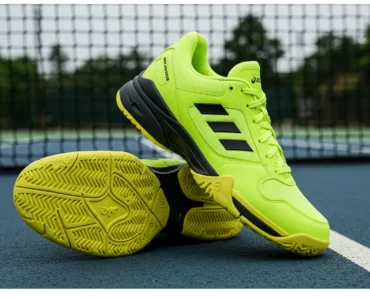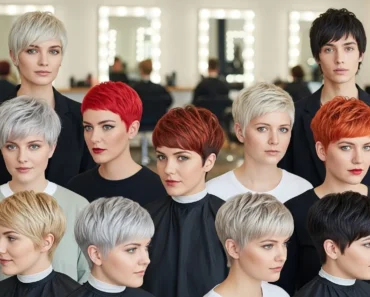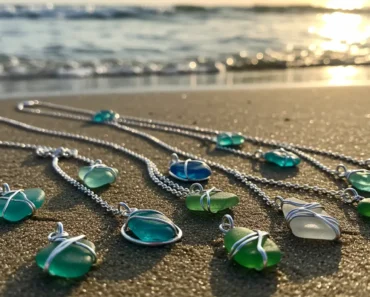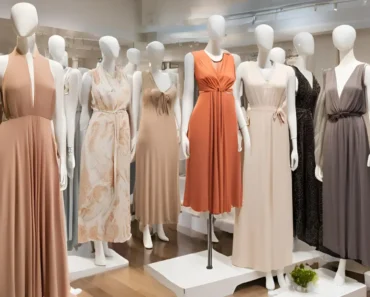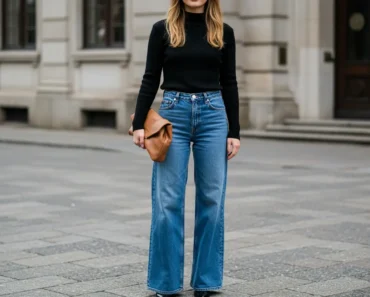Master the art of selecting, styling, and caring for cashmere, silk, and designer scarves
Scarves rank among fashion’s most versatile accessories, transforming simple outfits into statement looks while providing warmth and comfort. Whether you seek a luxurious cashmere wrap, a silk Hermès square, or a handmade crochet piece, understanding how to select and style scarves elevates your wardrobe throughout every season. This guide walks you through everything from choosing quality materials to mastering trendy styling techniques that work for your lifestyle.
Understanding Scarf Materials and Quality
The fabric you choose determines how your scarf looks, feels, and performs throughout the year. Each material offers distinct advantages suited to different climates and occasions.
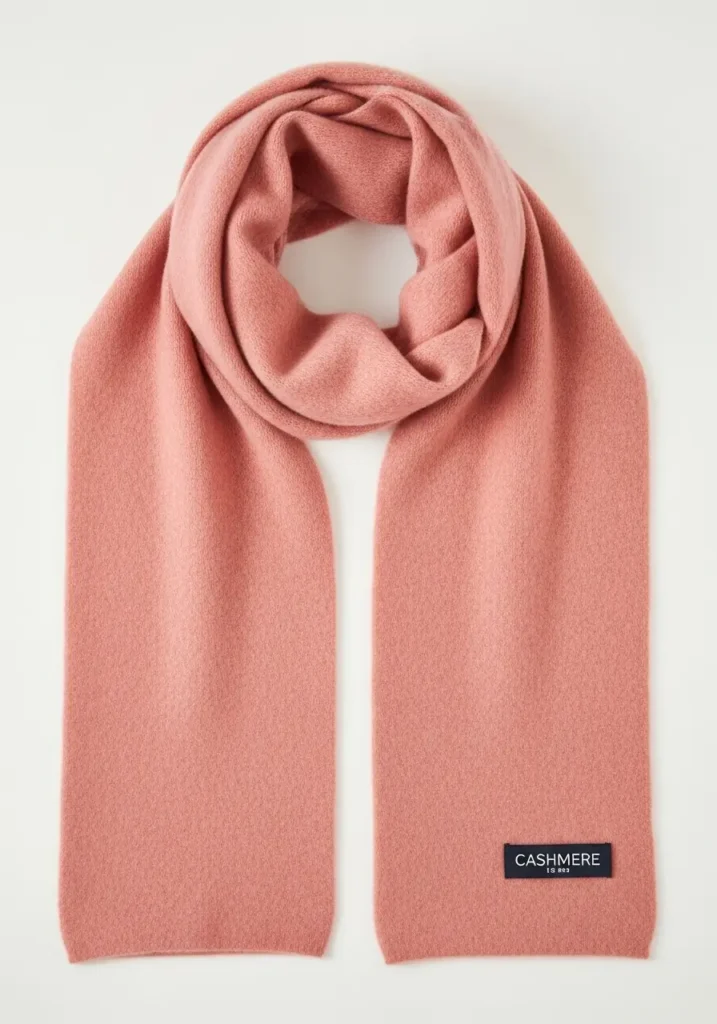
Cashmere scarves represent the pinnacle of luxury and comfort. Made from the soft undercoat of cashmere goats, these scarves deliver exceptional warmth without bulk. The finest cashmere comes from regions like Mongolia and features fibers measuring just 12 to 15 microns in thickness, creating that signature smooth texture. High-quality cashmere becomes even softer with proper care, making it a worthwhile investment that lasts for years. When shopping for cashmere, look for Grade A fibers, which consist of the longest and finest strands that resist pilling and maintain their luxurious feel.
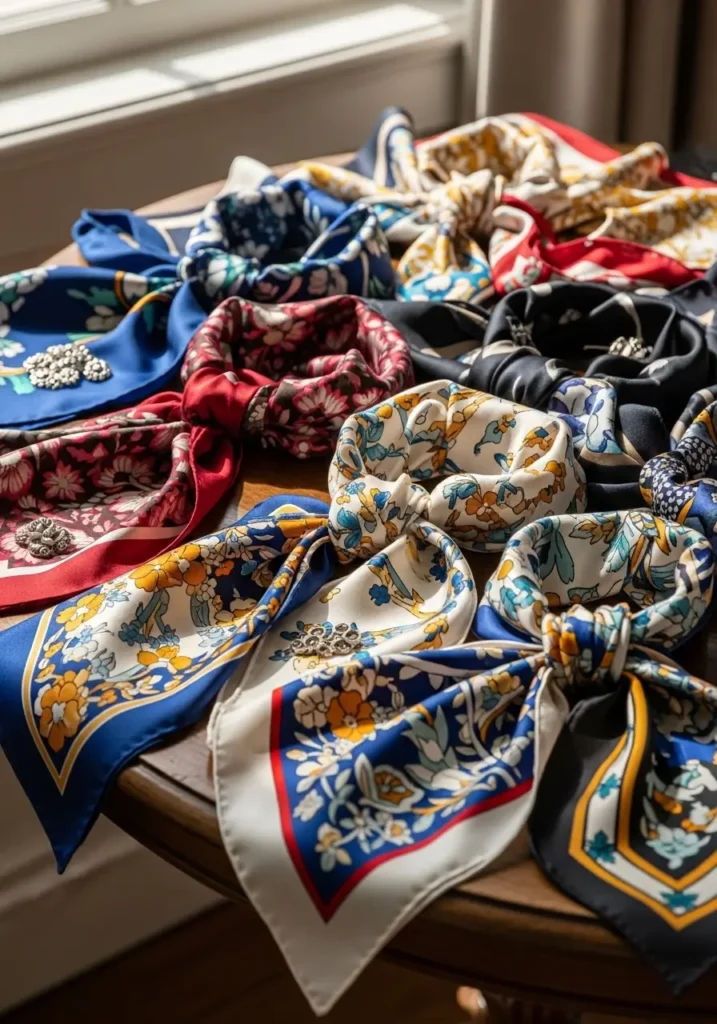
Silk scarves offer timeless elegance with their natural sheen and soft drape. Brands like Hermès craft their iconic pieces from mulberry silk woven at a density of 450 threads per square centimeter, creating scarves thick enough to last decades while remaining lightweight. Silk naturally regulates temperature, keeping you cool in summer and warm in winter, while its hypoallergenic properties make it ideal for sensitive skin. The smooth texture of silk also helps retain moisture close to your skin and reduces hair frizz when worn as a headscarf.
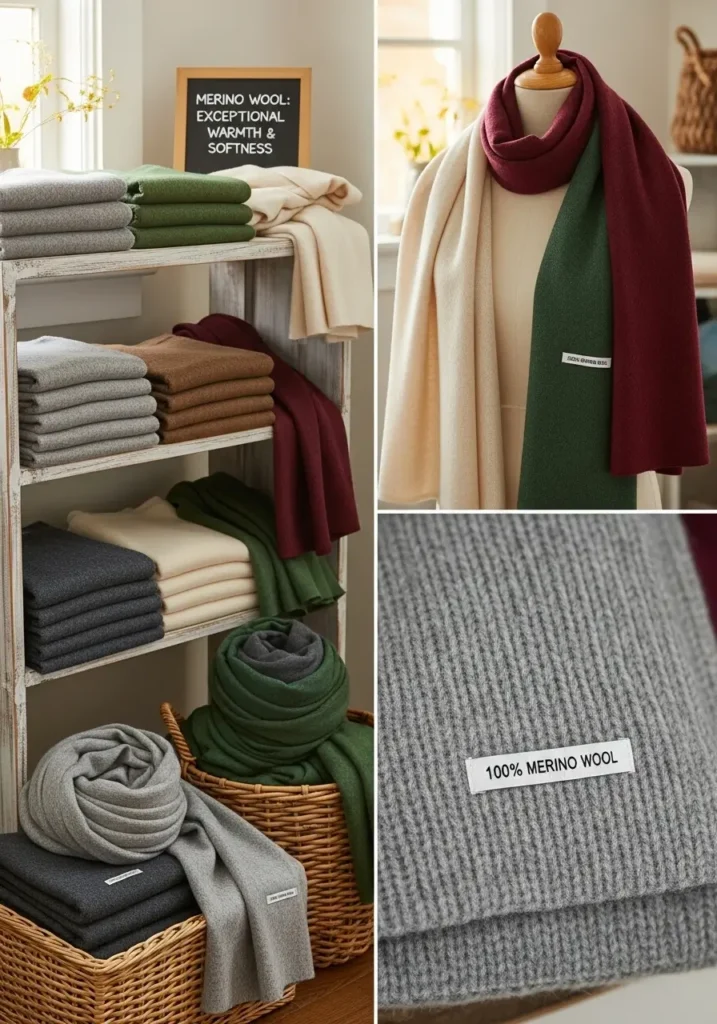
Wool scarves provide durable warmth for cold weather. Merino wool offers exceptional softness compared to traditional wool varieties, while maintaining excellent insulation properties. Wool’s natural crimp creates tiny air pockets that trap heat, making these scarves ideal for harsh winter conditions. The material resists wrinkles and naturally repels odors, requiring less frequent washing than other fabrics.
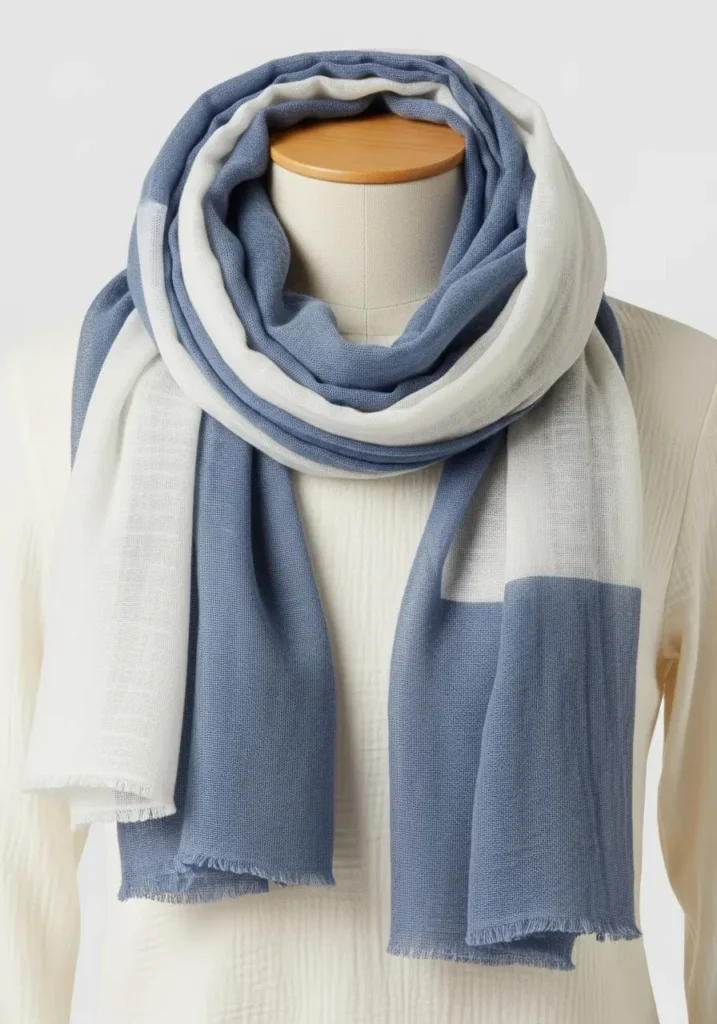
Cotton scarves shine as the best choice for summer wear due to their breathability and comfort. Cotton allows air circulation while absorbing moisture, keeping you fresh in warm weather. These scarves come in countless weights and weaves, from lightweight gauze to substantial knits, offering options for every occasion. Cotton also handles frequent laundering better than delicate fabrics, though it wrinkles more easily.
For those with sensitive skin, consider baby alpaca wool, which delivers softness without the itchiness associated with regular wool. Bamboo and organic cotton also provide comfortable alternatives that avoid irritation. Always check for allergen-free dyes and ethical production practices when selecting scarves for sensitive skin.
Luxury Designer Scarves Worth the Investment
Luxury scarves from heritage brands combine exceptional craftsmanship with timeless designs that retain value over time.
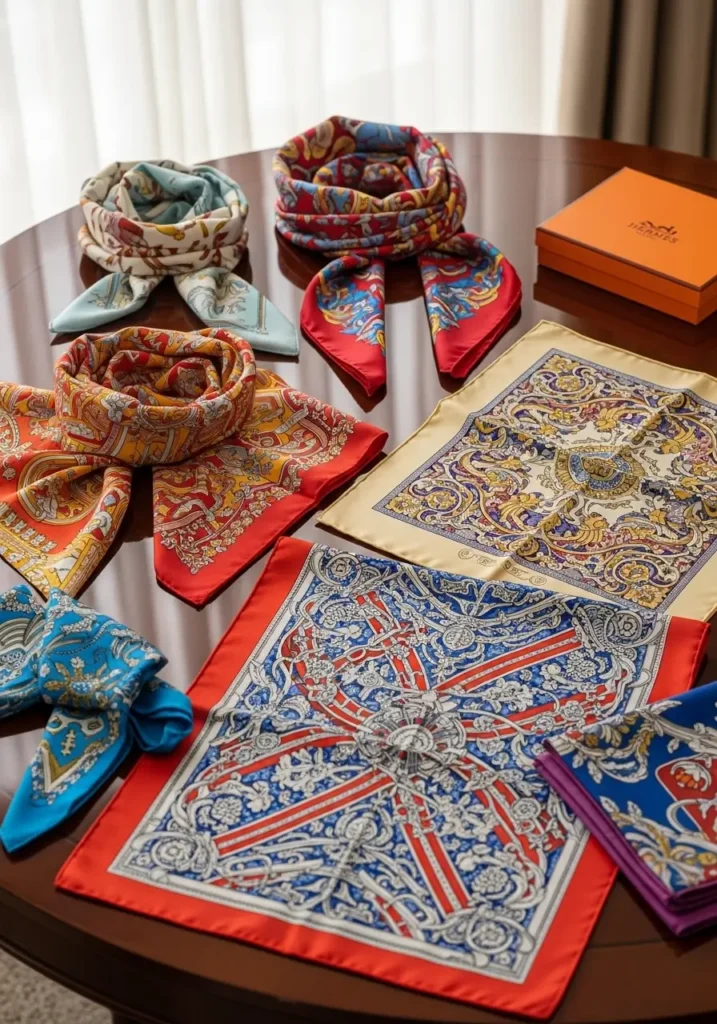
Hermès scarves stand as the undisputed leader in luxury silk accessories. Each 90 x 90 cm Carré scarf can take up to two years to produce, from initial design through screen printing to hand-rolling the edges. The brand offers over 2,000 original designs inspired by art, culture, and nature, ensuring each piece tells a unique story. While new Hermès scarves average $600 to $700, preowned options offer the same exceptional quality at $200 to $300.
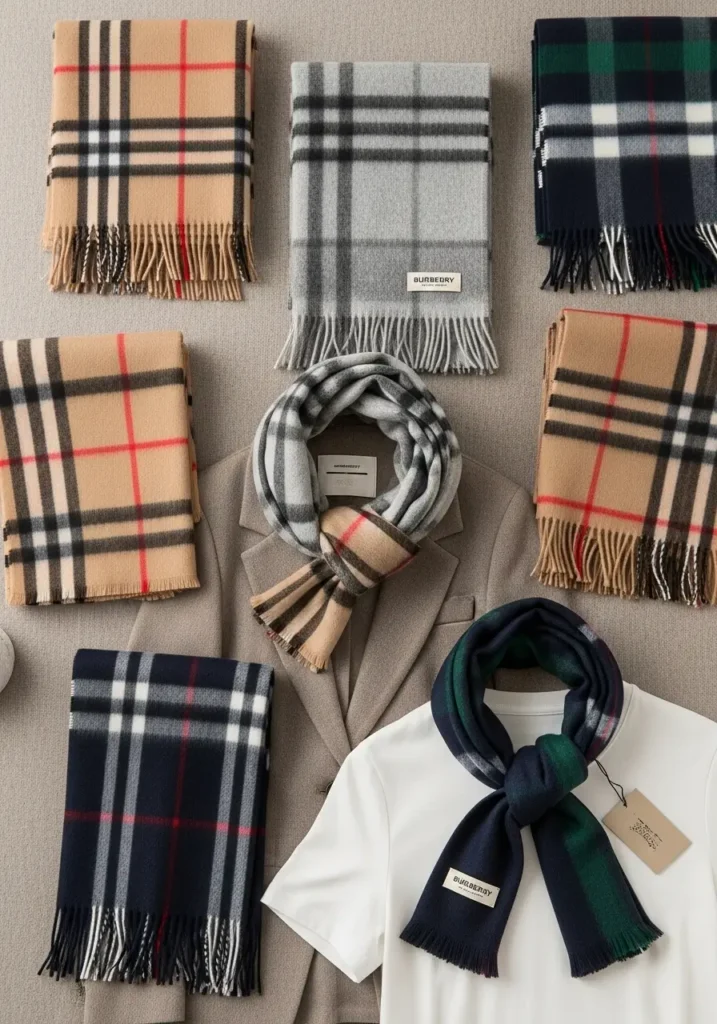
Burberry scarves showcase British heritage through their iconic check pattern crafted from luxurious cashmere. Each scarf undergoes washing in local spring water to achieve its signature glossy finish. The classic design works with both casual and formal outfits, making it a versatile investment that complements any wardrobe.
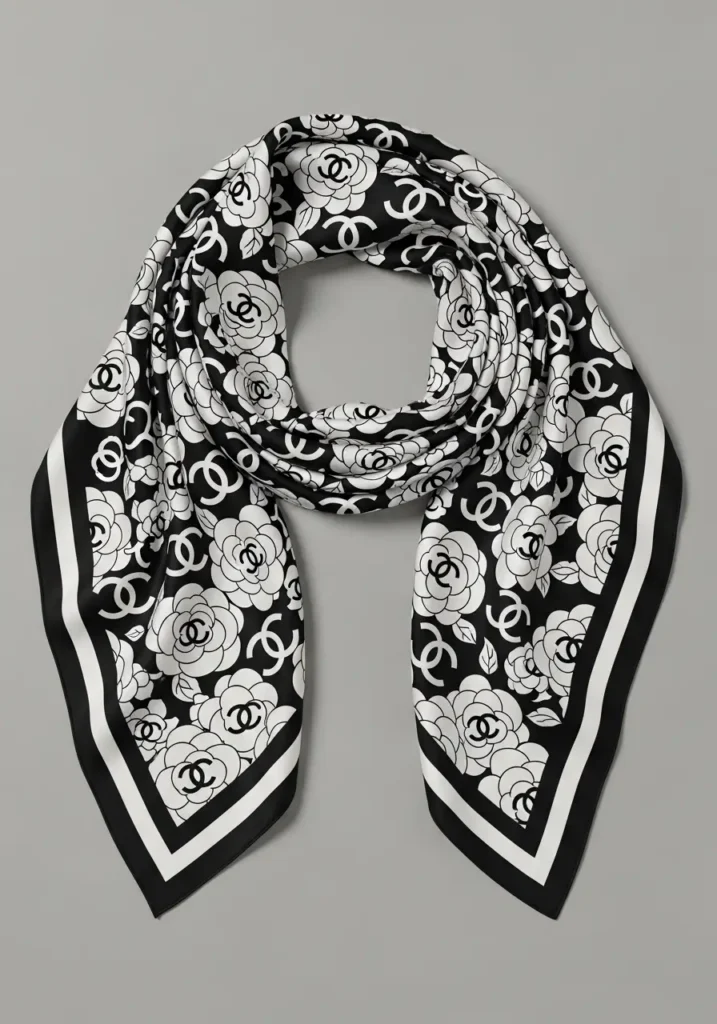
Chanel scarves bring Parisian sophistication with signature camellia motifs and double-C logos printed on premium silk twill. The brand balances heritage codes with contemporary luxury appeal through seasonal collections that maintain timeless elegance. These scarves typically range from $350 to $700, reflecting the brand’s position in the luxury market.
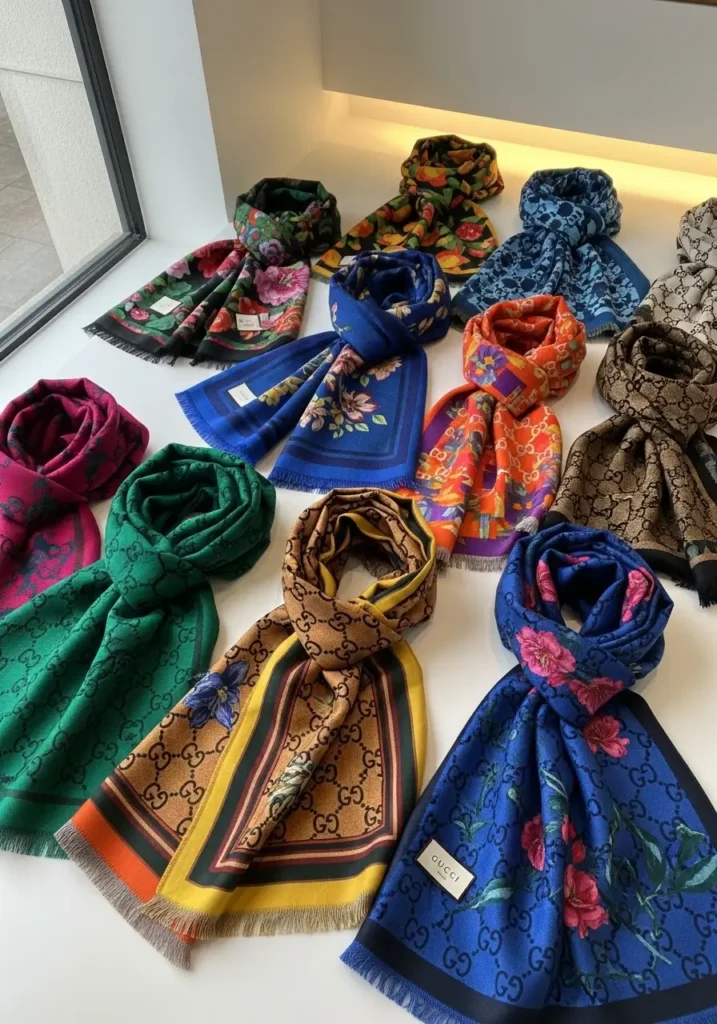
Gucci scarves embody modern Italian luxury with bold, eclectic prints that make strong fashion statements. The brand’s commitment to sustainability adds value for environmentally conscious consumers. Prices range from $300 to $600, positioning Gucci as a contemporary alternative to more traditional luxury houses.
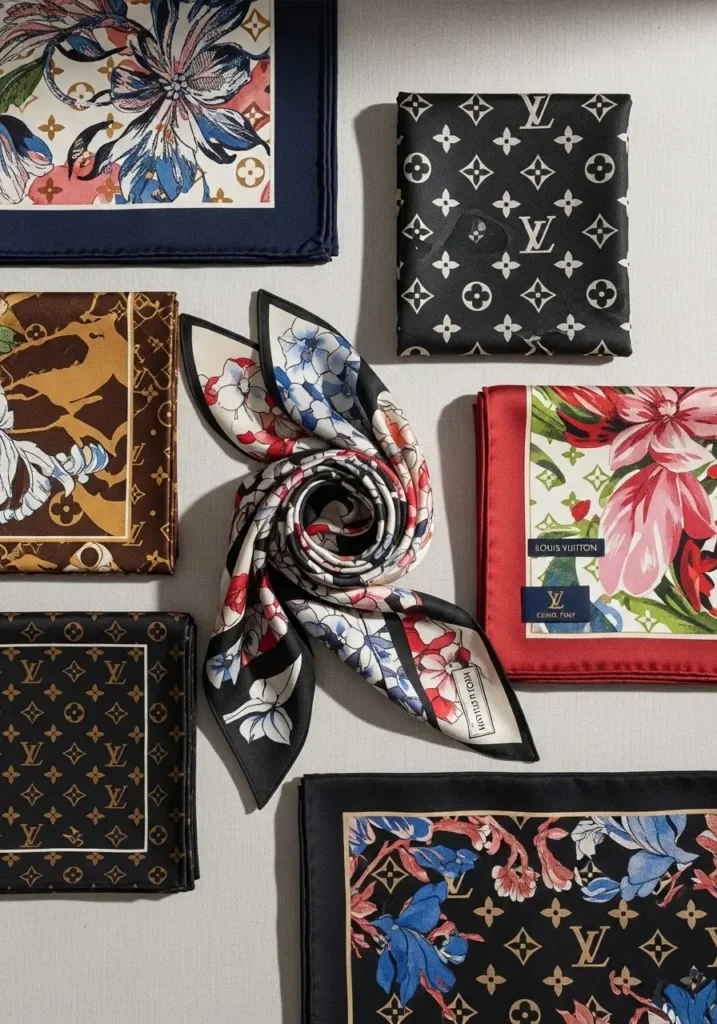
Louis Vuitton scarves feature the brand’s iconic monogram patterns alongside seasonal designs. Crafted in Como, Italy, these scarves use premium silk twill construction with luxury brand positioning. Expect to invest $400 to $800 for Louis Vuitton scarves through boutiques and online platforms.
How to Style Scarves for Every Season
Modern scarf styling focuses on effortless elegance rather than complicated techniques, adapting to both practical needs and fashion trends throughout the year.
Spring and Summer Styling
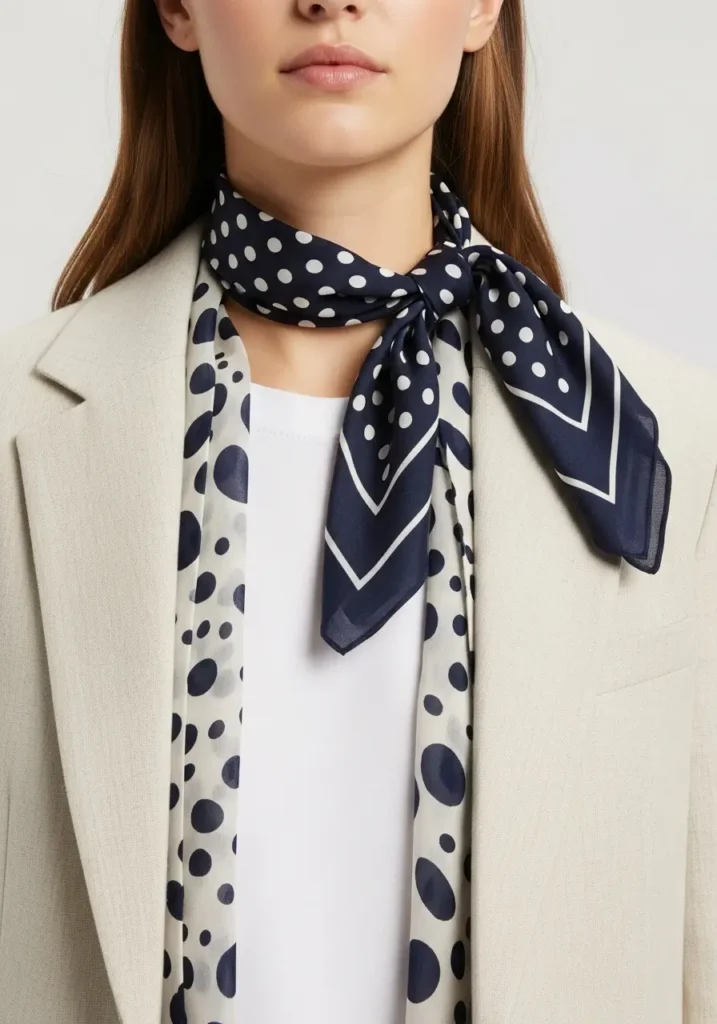
Lightweight silk and cotton scarves add sophistication to warm-weather outfits without overheating. The side-shoulder drape creates a relaxed yet elegant look for spring. Simply tie a large square silk scarf at your shoulder, letting the fabric flow naturally over your torso. This styling works beautifully over sundresses and light blouses.
For a subtle face-brightening effect, tie a silk scarf to one side of your neck. This asymmetrical placement adds visual interest while keeping hair away from your face on breezy days. Small silk squares make a strong comeback in 2025, offering endless styling options. Tie one loosely at your neck, knot it to the side, or tuck it into a sweater neckline for a pop of color.
The neckerchief style dominates New York street fashion, creating an effortlessly chic impression whether worn with formal attire or basic jeans and a white t-shirt. Layer a polka-dotted silk scarf between a button-down shirt and linen blazer for a graphic pop of elegance.
Fall and Winter Techniques
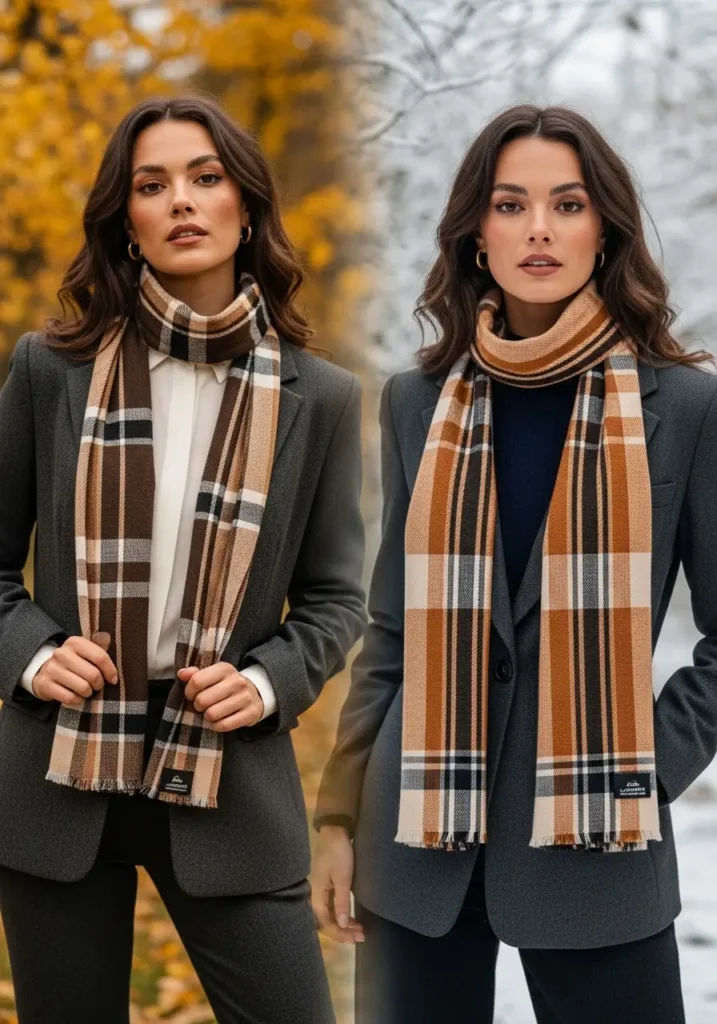
Long, lean scarves create flattering vertical lines that work with both tailored and casual outfits. Look for lightweight wool, silk blends, or soft cashmere for the best drape. The wrap-around method provides maximum warmth while maintaining style. Drape a long scarf around your neck and let the ends fall naturally, or fold the scarf in half, drape it around your neck, and pull the ends through the loop for a soft frame around your face.
Knitted scarves with texture add interest to structured outerwear. Ribbed knits, wide flat weaves, and hand-crocheted styles pair beautifully with coats and jackets. For extra warmth, try the double loop technique with extra-long scarves. This creates layers of insulation around your neck without adding excessive bulk.
Oversized scarves work as shawl layers when placed across your shoulders over blazers or dresses. This styling adds sophistication to professional settings while providing adjustable warmth.
Related Post: 19 Style Secrets for Wearing Wide Leg Pants That Fashion Insiders Swear By
Mastering Different Scarf Tying Techniques
Learning versatile tying methods allows you to create multiple looks with each scarf in your collection.
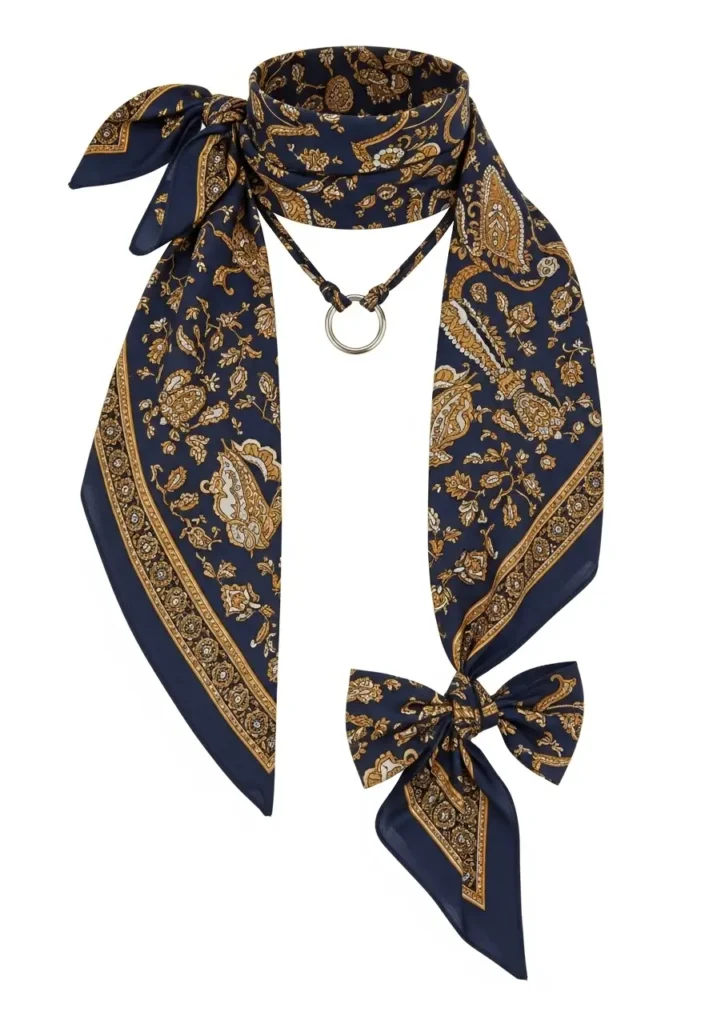
The Loop and Knot: Fold your scarf in half so the two ends touch, then drape it over your neck with the loop on one side. Pull the ends through the loop and adjust the tightness near your neck. This classic technique works with scarves of any length and provides good coverage on cold days.
The European Ascot: Wrap the scarf around your neck with one end shorter than the other. Take the long piece and wrap it around your neck like a choker, ensuring both ends hang evenly in front. Place one end over the other and thread it up along the side, letting it waterfall over the top. This creates an elegant, equestrian-inspired look perfect for adding sophistication to basic pieces.
The Twisted Choker: Fold your scarf into a long strip and wrap it around your neck. Twist the ends twice and tie them at the back. This creates a decorative accent right at your collarbone, adding interest without overwhelming your outfit.
The Bow Tie Method: Take both ends of a folded scarf and tie them together at once to create one large knot. You can leave both ends hanging out or spread the first layer to create a tie effect while hiding the second end. This styling works particularly well with silk scarves for a polished finish.
The Ring Accent: For a simple yet striking look, roll your scarf and wrap it around your neck. Thread both ends through a decorative ring, then slide the ring to your preferred position. You can wear the ring centered on your chest to showcase jewelry or tuck the ends through for additional security.
Creating Scarf Tops for Summer
Transforming scarves into tops offers creative styling options for warm weather while maximizing your accessory collection.
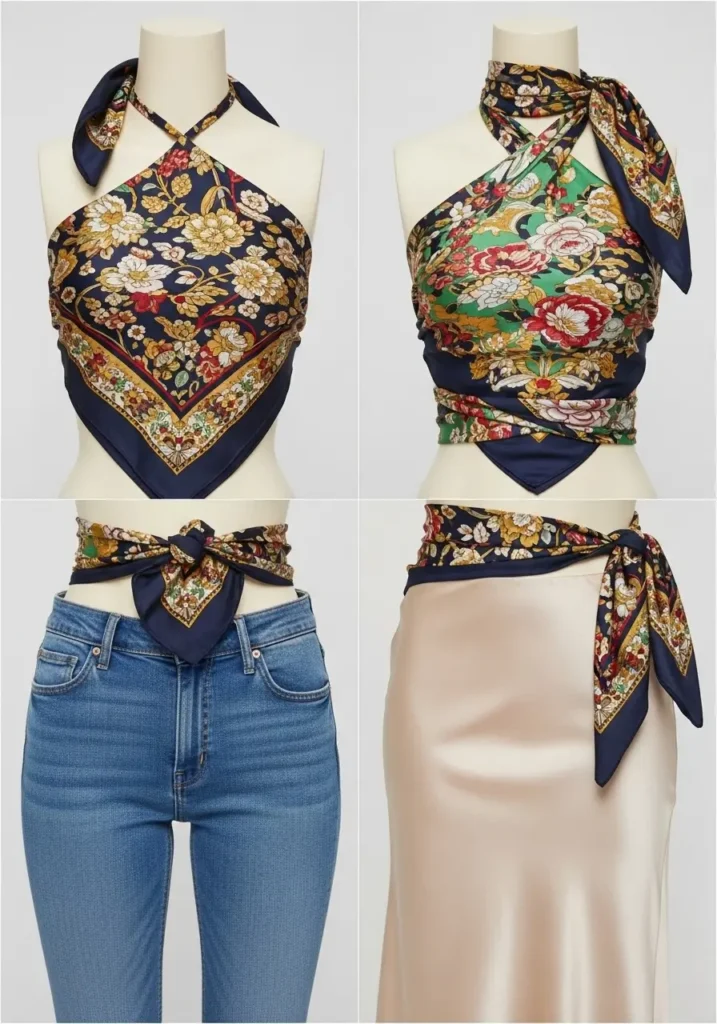
Triangle Halter Top: Fold a large square scarf into a triangle and place it against your chest with the point facing down. Bring the two upper corners behind your neck and tie them securely. Take the two side corners and tie them behind your back at your natural waist. This classic style works with strapless bras or can be worn braless depending on your comfort level.
Bandeau Wrap: Fold your scarf into a long rectangle and wrap it around your chest, positioning it where you want coverage. Cross the ends behind your back and bring them forward over your shoulders. Tie the ends at the back of your neck, letting any excess fabric hang down your back. This style provides more coverage than traditional triangle tops.
One-Shoulder Drape: Place a square scarf diagonally across your chest, with one corner at your shoulder and the opposite corner at your hip. Tie the upper corners together at your shoulder, then bring the lower corners around your waist and tie them at your back. This asymmetrical style creates a sophisticated silhouette perfect for beach coverups or casual summer gatherings.
Pair scarf tops with high-waisted jeans for a balanced silhouette. The combination of fitted bottoms and flowing tops creates flattering proportions. For dressier occasions, match scarf tops with satin maxi skirts and elegant sandals.
Hair and Head Scarf Styling
Scarves add elegance and personality to hairstyles while serving practical purposes like taming flyaways and protecting hair.
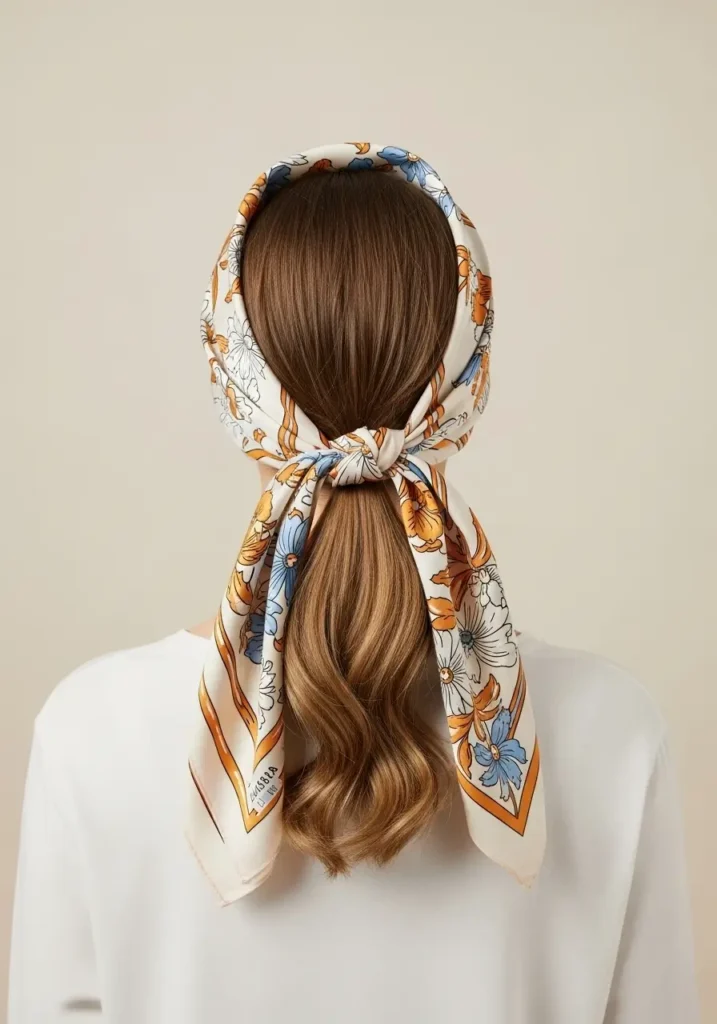
Classic Headband Style: Fold a square scarf into a long strip by rolling it from one corner. Place the scarf at your hairline and wrap it around the back of your head. Bring both ends forward and twist them once, then wrap them back around your head. Tie the ends at the back in a secure knot. Push the scarf back slightly from your forehead to show about an inch of hair in front.
Ponytail Wrap: Create a ponytail at your desired height and secure it with a hair elastic. Fold your scarf into a long strip and thread it through the elastic so both ends hang evenly. Tie the ends in a bow above your ponytail for a classic look, or wrap them around the base of your ponytail for a sleeker finish.
Under-Chin Tie: Fold a square scarf into a triangle and place it over your head with the point at the back. Bring the two corners forward under your chin and tie them in a knot. This vintage-inspired style channels icons like Audrey Hepburn and Grace Kelly while providing practical protection from wind.
Bandana Style at Nape: Fold a square scarf into a triangle and place it over your head. Instead of tying under your chin, bring the ends to the nape of your neck and tie them there. This creates a more casual, modern interpretation of the classic headscarf that works well for everyday wear.
When wearing hair scarves, silk material works best because it has more grip than polyester when tying knots. Scarves measuring 35 by 35 inches provide enough length for most styling techniques.
Selecting Scarves for Your Face Shape
Choosing scarves that complement your facial structure enhances your overall appearance and creates balanced proportions.
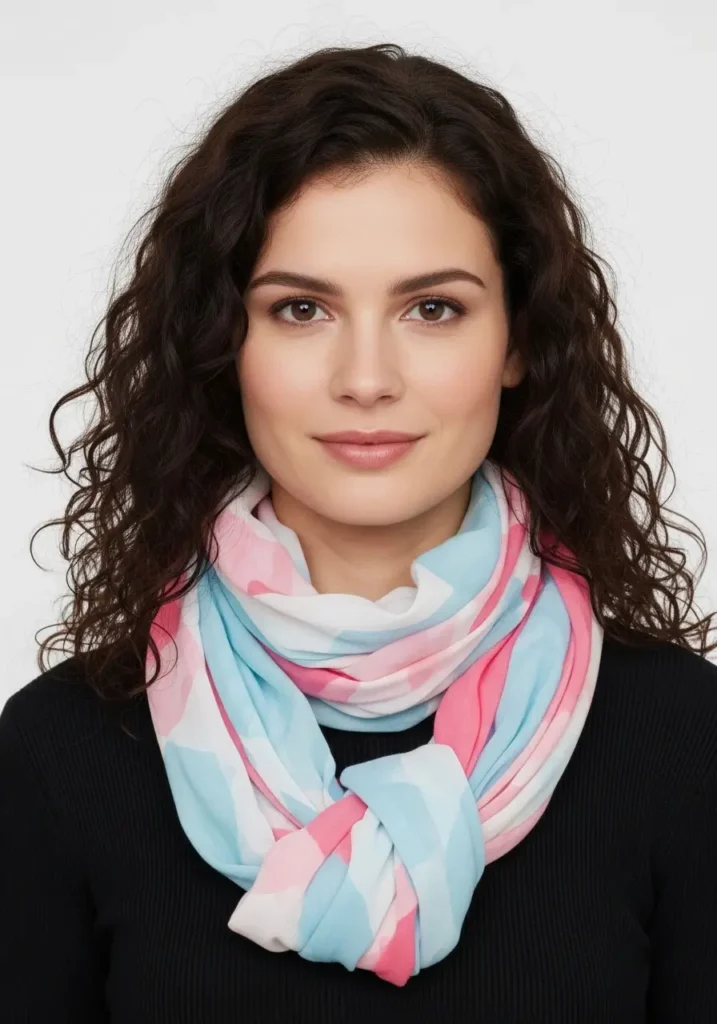
Oval Face Shape: Those with oval faces enjoy the most versatility in scarf selection. Balanced proportions allow you to experiment with bold patterns, chunky knits, or delicate silk scarves. Try draping scarves loosely around your neck or tying them in creative knots.
Round Face Shape: Round faces benefit from long, flowing scarves that create the illusion of length. Choose vertical drapes and thin fabrics like chiffon or silk to elongate your facial structure. Avoid chunky or tight styles that can add extra width.
Square Face Shape: Strong jawlines and broad foreheads look best with soft, flowing scarves that soften angular features. Infinity scarves or loose, rounded styles balance the sharpness of square faces. Avoid overly structured or boxy styles that emphasize angles.
Heart-Shaped Face Shape: Heart-shaped faces feature wider foreheads and narrow chins. Light, airy scarves that add volume around the neck balance these proportions. Triangle-shaped scarves or loose draping styles work particularly well.
Oblong Face Shape: Faces longer than they are wide require shorter scarves or bulkier styles like cowls and chunky knits. These styles add width and balance to elongated features. Avoid scarves that hang straight down, as they can make faces appear even longer.
Proper Scarf Care and Maintenance
Correct care extends the life of your scarves while maintaining their beauty and softness.
Washing Cashmere and Wool
Hand washing represents the best method for cleaning delicate wool and cashmere scarves. Fill a basin with cold or lukewarm water not exceeding 30°C (86°F) and add a small amount of detergent specifically formulated for delicate fabrics. Fully dissolve the detergent before submerging your scarf. Gently press the scarf between your hands rather than rubbing or twisting the fabric.
Rinse the scarf multiple times in cold water until all soap residue disappears. Never wring woolen products, as this damages the fibers. Instead, lay the scarf flat on a clean towel and roll the towel tightly to absorb excess water. Unroll the towel and lay the scarf flat on a dry surface away from direct sunlight and heat sources.
Caring for Silk Scarves
Silk requires especially gentle treatment to maintain its luster and strength. Hand wash silk scarves in cold water using mild, fragrance-free soap or baby shampoo. Never use conventional detergents containing enzymes, bleaching agents, or harsh fragrances that can damage delicate silk fibers.
When treating stains on silk, dab gently with a clean cloth dampened with lukewarm water and mild soap. Avoid rubbing or stretching the fabric, which can cause permanent damage. After washing, gently press the scarf between towels to remove excess water rather than twisting or wringing.
Storage Best Practices
Store scarves in cool, dry places away from direct sunlight, which fades colors and weakens textiles. Fold scarves neatly rather than hanging them, as hanging can cause stretching and distortion over time. Place scarves in breathable cotton storage bags or boxes rather than plastic, which traps moisture and can lead to mildew.
Use natural moth repellents like cedar discs, lavender, or peppermint essential oils when storing wool and cashmere scarves. Replace moth repellents regularly and check stored scarves periodically for signs of damage.
Key Takeaways:
- ✓Cashmere and silk scarves offer luxury, warmth, and versatility across seasons
- ✓Designer scarves from Hermès, Burberry, and Chanel retain value as investment pieces
- ✓Master simple tying techniques like the loop-and-knot and European ascot for effortless style
- ✓Choose scarves based on face shape to create balanced, flattering proportions
- ✓Proper care including hand washing and correct storage extends scarf lifespan dramatically
Current Scarf Trends and Market Insights
Understanding fashion trends and market dynamics helps you make informed purchasing decisions while staying current with style evolution.
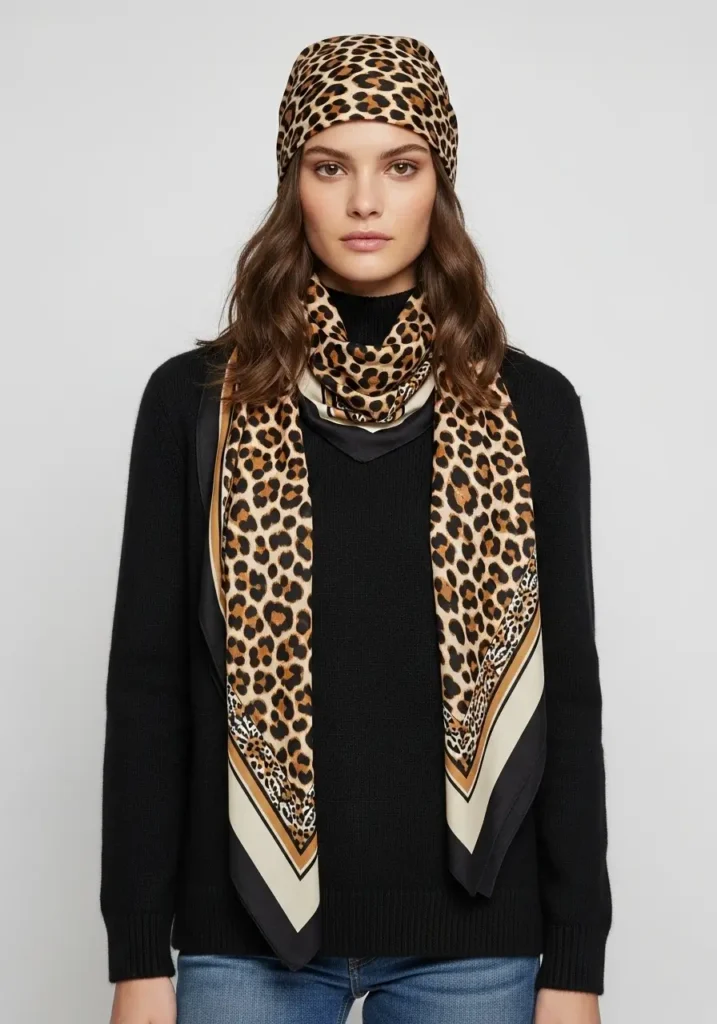
2025 Style Trends
Long, lean scarves dominate fall 2025 fashion, creating flattering vertical lines that complement both tailored and casual outfits. Skinny scarves make a strong comeback after years of oversized dominance, offering a sleek alternative that adds interest without bulk. Leopard print skinny scarves particularly stand out, bringing instant personality to basic outfits.
Triangle scarves emerge as another major trend, offering versatility when worn over knitwear, tailored shirts, or outerwear. The angular shape creates a chic, unexpected silhouette that differs from traditional rectangular styles. Bandana-style headscarves appear everywhere from Gucci runways to celebrity street style, channeling vintage glamour through modern interpretations.
Market Growth and Statistics
The global scarf market demonstrates robust growth, valued at $22 billion in 2023 and projected to reach $34 billion by 2032 at a CAGR of 5.2%. The luxury scarf segment shows even stronger performance, expected to grow from $1.66 billion to $2.16 billion by 2028. This expansion reflects rising consumer spending on fashion accessories and growing awareness of scarves as statement pieces rather than purely functional items.
Asia Pacific dominates the market with a 37.86% share in 2024, driven by rising disposable incomes and expanding middle-class populations. North America and Europe represent mature markets with steady growth, characterized by strong demand for both luxury and sustainable options.
E-commerce platforms significantly impact market growth by expanding access to diverse styles and price points. Social media and influencer marketing drive awareness and demand, particularly among younger consumers seeking trendy accessories.
Frequently Asked Questions
How do I choose the right scarf length for my height?
Your height determines the ideal scarf length for proportional styling. Petite individuals under 5’4″ should select scarves measuring 60 to 70 inches long to avoid overwhelming their frame. These shorter lengths allow for neat wrapping without excessive fabric bunching at the neck. Average heights between 5’4″ and 5’8″ work well with standard scarf lengths of 70 to 80 inches, offering versatility for various tying techniques. Taller individuals over 5’8″ look best in scarves measuring 80 inches or longer, providing adequate length for comfortable draping and multiple wraps around the neck. When shopping, hold scarves against your body to visualize proportions before purchasing.
What’s the difference between real and fake cashmere?
Authentic cashmere feels incredibly soft and smooth against your skin without any roughness or itchiness. Real cashmere fibers measure 12 to 15 microns in thickness, creating a luxurious texture that synthetic alternatives cannot replicate. When performing a stretch test, genuine cashmere springs back to its original shape, while fake cashmere stays stretched or becomes misshapen. High-quality cashmere features a tight weave with tiny fibers about 2mm in length visible on the surface. Price provides another clue – authentic cashmere scarves rarely cost less than $100 due to the labor-intensive production process and limited supply of premium fibers. Always check labels for “100% cashmere” from reputable brands.
Can I wear silk scarves in winter?
Silk scarves work beautifully in winter when layered properly for warmth and style. Silk naturally regulates temperature and provides more insulation than its lightweight nature suggests. Layer a silk scarf under a wool coat for an elegant pop of color visible at your neckline, or wrap it over a turtleneck for added sophistication. For maximum warmth, choose thicker silk twill scarves rather than lighter chiffon styles. The 450-thread density found in luxury silk scarves like Hermès provides substantial warmth while maintaining elegance. However, save delicate silk scarves for dry winter days, as moisture can damage the fibers and cause water spots that require professional cleaning.
How often should I wash my scarves?
Washing frequency depends on fabric type and how frequently you wear each scarf. Cashmere and wool scarves need washing only 2 to 3 times per season unless visibly soiled or odorous. These natural fibers resist bacteria and odors, requiring less frequent cleaning than synthetic materials. Silk scarves should be spot-cleaned as needed and fully washed only when absolutely necessary, as frequent washing damages delicate fibers. Cotton scarves tolerate more frequent washing – clean them every 3 to 4 wears or whenever they appear dirty. Between washes, air out scarves by hanging them in a well-ventilated area for several hours. Always address stains immediately rather than waiting for scheduled washing, as set-in stains become increasingly difficult to remove without damaging fabric.
Are designer scarves worth the investment?
Luxury designer scarves justify their cost through superior craftsmanship, timeless designs, and exceptional durability. Brands like Hermès and Burberry use the finest materials and traditional production methods that ensure scarves last for decades with proper care. A $600 Hermès scarf might seem expensive initially, but when divided by 20 or 30 years of use, the cost per wear becomes remarkably reasonable. Designer scarves also retain resale value, with vintage Hermès pieces often selling for several hundred dollars on secondary markets. The preowned market offers an accessible entry point, with authentic designer scarves available at 50% to 70% below retail prices. If budget concerns limit your options, consider starting with one exceptional designer scarf in a versatile color and pattern rather than multiple lower-quality alternatives.
Final Thoughts
Scarves transform outfits from ordinary to exceptional through thoughtful selection and creative styling. Understanding materials, caring for your collection properly, and mastering versatile tying techniques allows you to maximize each scarf’s potential across multiple seasons and occasions. Whether you invest in heritage luxury pieces or build a collection of affordable everyday options, quality craftsmanship and timeless designs ensure your scarves remain wardrobe staples for years to come.
The scarf market continues evolving with growing emphasis on sustainability, personalization, and versatile styling options. Start building your scarf collection today by selecting one or two high-quality pieces in colors that flatter your complexion and pair well with your most-worn outfits.






